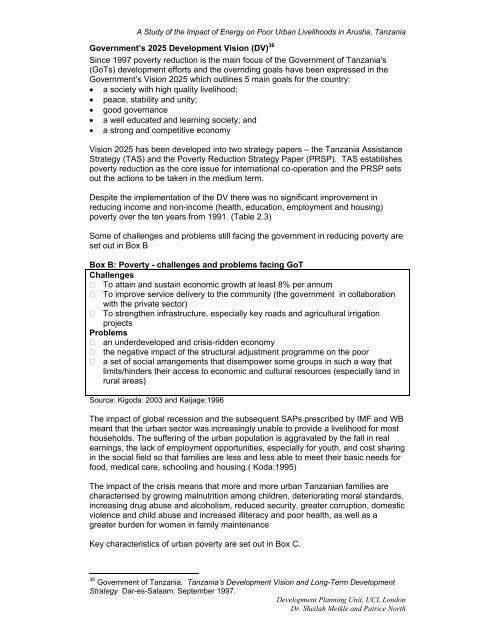The Impact of Energy Use on Poor Urban Livelihoods in ... - DfID
The Impact of Energy Use on Poor Urban Livelihoods in ... - DfID
The Impact of Energy Use on Poor Urban Livelihoods in ... - DfID
Create successful ePaper yourself
Turn your PDF publications into a flip-book with our unique Google optimized e-Paper software.
A Study <str<strong>on</strong>g>of</str<strong>on</strong>g> the <str<strong>on</strong>g>Impact</str<strong>on</strong>g> <str<strong>on</strong>g>of</str<strong>on</strong>g> <str<strong>on</strong>g>Energy</str<strong>on</strong>g> <strong>on</strong> <strong>Poor</strong> <strong>Urban</strong> <strong>Livelihoods</strong> <strong>in</strong> Arusha, Tanzania<br />
Government’s 2025 Development Visi<strong>on</strong> (DV) 36<br />
S<strong>in</strong>ce 1997 poverty reducti<strong>on</strong> is the ma<strong>in</strong> focus <str<strong>on</strong>g>of</str<strong>on</strong>g> the Government <str<strong>on</strong>g>of</str<strong>on</strong>g> Tanzania's<br />
(GoTs) development efforts and the overrid<strong>in</strong>g goals have been expressed <strong>in</strong> the<br />
Government’s Visi<strong>on</strong> 2025 which outl<strong>in</strong>es 5 ma<strong>in</strong> goals for the country:<br />
• a society with high quality livelihood;<br />
• peace, stability and unity;<br />
• good governance<br />
• a well educated and learn<strong>in</strong>g society; and<br />
• a str<strong>on</strong>g and competitive ec<strong>on</strong>omy<br />
Visi<strong>on</strong> 2025 has been developed <strong>in</strong>to two strategy papers – the Tanzania Assistance<br />
Strategy (TAS) and the Poverty Reducti<strong>on</strong> Strategy Paper (PRSP). TAS establishes<br />
poverty reducti<strong>on</strong> as the core issue for <strong>in</strong>ternati<strong>on</strong>al co-operati<strong>on</strong> and the PRSP sets<br />
out the acti<strong>on</strong>s to be taken <strong>in</strong> the medium term.<br />
Despite the implementati<strong>on</strong> <str<strong>on</strong>g>of</str<strong>on</strong>g> the DV there was no significant improvement <strong>in</strong><br />
reduc<strong>in</strong>g <strong>in</strong>come and n<strong>on</strong>-<strong>in</strong>come (health, educati<strong>on</strong>, employment and hous<strong>in</strong>g)<br />
poverty over the ten years from 1991. (Table 2.3)<br />
Some <str<strong>on</strong>g>of</str<strong>on</strong>g> challenges and problems still fac<strong>in</strong>g the government <strong>in</strong> reduc<strong>in</strong>g poverty are<br />
set out <strong>in</strong> Box B<br />
Box B: Poverty - challenges and problems fac<strong>in</strong>g GoT<br />
Challenges<br />
To atta<strong>in</strong> and susta<strong>in</strong> ec<strong>on</strong>omic growth at least 8% per annum<br />
To improve service delivery to the community (the government <strong>in</strong> collaborati<strong>on</strong><br />
with the private sector)<br />
To strengthen <strong>in</strong>frastructure, especially key roads and agricultural irrigati<strong>on</strong><br />
projects<br />
Problems<br />
an underdeveloped and crisis-ridden ec<strong>on</strong>omy<br />
the negative impact <str<strong>on</strong>g>of</str<strong>on</strong>g> the structural adjustment programme <strong>on</strong> the poor<br />
a set <str<strong>on</strong>g>of</str<strong>on</strong>g> social arrangements that disempower some groups <strong>in</strong> such a way that<br />
limits/h<strong>in</strong>ders their access to ec<strong>on</strong>omic and cultural resources (especially land <strong>in</strong><br />
rural areas)<br />
Source: Kigoda: 2003 and Kaijage:1996<br />
<str<strong>on</strong>g>The</str<strong>on</strong>g> impact <str<strong>on</strong>g>of</str<strong>on</strong>g> global recessi<strong>on</strong> and the subsequent SAPs prescribed by IMF and WB<br />
meant that the urban sector was <strong>in</strong>creas<strong>in</strong>gly unable to provide a livelihood for most<br />
households. <str<strong>on</strong>g>The</str<strong>on</strong>g> suffer<strong>in</strong>g <str<strong>on</strong>g>of</str<strong>on</strong>g> the urban populati<strong>on</strong> is aggravated by the fall <strong>in</strong> real<br />
earn<strong>in</strong>gs, the lack <str<strong>on</strong>g>of</str<strong>on</strong>g> employment opportunities, especially for youth, and cost shar<strong>in</strong>g<br />
<strong>in</strong> the social field so that families are less and less able to meet their basic needs for<br />
food, medical care, school<strong>in</strong>g and hous<strong>in</strong>g.( Koda:1995)<br />
<str<strong>on</strong>g>The</str<strong>on</strong>g> impact <str<strong>on</strong>g>of</str<strong>on</strong>g> the crisis means that more and more urban Tanzanian families are<br />
characterised by grow<strong>in</strong>g malnutriti<strong>on</strong> am<strong>on</strong>g children, deteriorat<strong>in</strong>g moral standards,<br />
<strong>in</strong>creas<strong>in</strong>g drug abuse and alcoholism, reduced security, greater corrupti<strong>on</strong>, domestic<br />
violence and child abuse and <strong>in</strong>creased illiteracy and poor health, as well as a<br />
greater burden for women <strong>in</strong> family ma<strong>in</strong>tenance<br />
Key characteristics <str<strong>on</strong>g>of</str<strong>on</strong>g> urban poverty are set out <strong>in</strong> Box C.<br />
36<br />
Government <str<strong>on</strong>g>of</str<strong>on</strong>g> Tanzania. Tanzania’s Development Visi<strong>on</strong> and L<strong>on</strong>g-Term Development<br />
Strategy Dar-es-Salaam: September 1997.<br />
Development Plann<strong>in</strong>g Unit, UCL L<strong>on</strong>d<strong>on</strong><br />
Dr. Sheilah Meikle and Patrice North
















